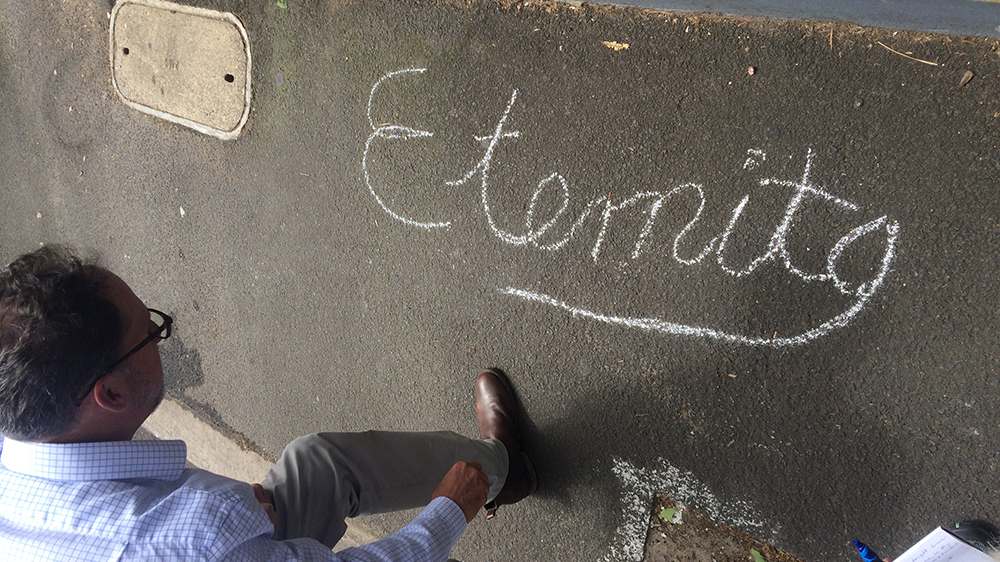I spent a day following the footsteps of a hero.
“He calculated he had written Eternity on the streets of Sydney, and further afield half a million times ” biographer Roy Williams says of Arthur Stace, his hero and mine, as we traced the literal steps of the man who used a stick of chalk to challenge his city.
And not just his city – “He took the Southern Aurora to Melbourne, and said he chalked far and wide” Williams, lawyer-turned-author-turned-tourguide told us.
Olive Tree Travel, a Melbourne-based company that normally tours to Israel, is being inventive in COVID times, and organised the tour tracing the sad then wonderfully redeemed life of Stace.
We started at the Eternity Bar and Grill, that occupies the ornate space in Central Station that once held the booking hall – where Stace must have booked for his Melbourne trip.
And then to his birthplace: a small red brick Victorian terrace in Surry Hills. It’s trendy now, but in 1885 the rented slum home of a family barely getting by on the allowance Arthur’s father, William Wood Stace – “a handsome man who became a no hoper” – received from his well-to-do family in Britain.
It was a tough time to be born in Sydney. What came later was worse. The 1890’s depression, and Laura cast further into poverty and abandoned by William. Arthur Stace’s saddest memory was of being taken to the Benevolent Asylum (where Central station is built) at age seven, by his mother Laura.
By the thirties, Stace had served as a stretcher bearer in WWI and returned to a career as a ‘cockatoo’ or lookout for gangsters at his sister’s brothel.
But then came redemption – we turn up at St Barnabas’ church on Sydney’s Broadway.
“Stace was trudging up here,” says Roy Williams, gesturing down Broadway from the railway station. “He came for a rock cake and found the rock of ages.”
“He had to sit through one hour of the gospel presentation and then you would get your feed. Arthur’s story was: ‘That night I came under conviction’. He left the church, walked back onto Broadway and into Victoria Park, where he stood under a fig tree, said a prayer, and was converted on the spot.”
“We believe Robert Hammond (the minister at the church on Broadway and a great organiser of relief efforts for the Great Depression’s poor) gave a sermon on Luke 18, and that is the reason that Stace prayed the ‘publican’s prayer’ of verse 30 ‘God be merciful to me a sinner’. He knelt and cried, and prayed that prayer.” It was August 6, 1930.”
We leave the church and head up the hill towards Sydney University, as Arthur Stace did.
We leave the church and head up the hill towards Sydney University, as Arthur Stace did. Here we have to guess – guess which fig tree in the park below the University Stace found to kneel and pray.
Whichever tree it was, “his life turned around overnight”. The first sign was that he gave up the grog immediately. You have to conclude it was the Holy Spirit working in him. Hammond immediately put Arthur to work at an asylum for alcoholic men in Ultimo.
Stace joined St Barnabas church, but on November 14, 1932 he found himself at the Baptist Tabernacle, in Burton Street. He heard a great sermon by war hero John Ridley, and we hear it too. Ridley had kept his notes and him re-preaching it was recorded decades later. The topic was “Echoes of Eternity” .
Ridley preached on Isiah 57:15 where God “who inhabits Eternity” seeks to “revive the Spirit of the Humble.” Stace, a humble man began his great spiritual adventure that night.
Ridley’s sermon concludes with a plea to see Eternity “written on the streets of Sydney.” Leaving the Tabernacle, Stace had a stick of chalk in his pocket and wrote “eternity” for the first of half a million times, on the pavement on the corner of Burton and Palmer streets.
Roy William tells the tour group, “If I could ask Arthur one question, I would ask him, ‘Why did you happen to have a stick of chalk in your pocket?”
Williams reveals a trade secret: as time went on, Stace actually used yellow washable crayon rather than chalk – it lasts longer.
Williams reveals a trade secret: as time went on, Stace actually used yellow washable crayon rather than chalk – it lasts longer.
And then to the cathedral, which we visit just as it emerges from seven months of COVID lockdown. Dean (Pastor) Kanishka Raffel, points out the Cathedral itself can’t take any credit for Stace’s ministry. But he preached on the street corner outside – and Raffel points to the Bathurst Street corner – where we had passed somebody preaching. It is still a favourite spot.
Such as it is at the other Eternity restaurant at Town Hall station. Its owned by a completely different company. This town really likes Eternity.
A highlight of the tour is a very small house in Bulwara road, Ultimo. As we approach we see a development notice on the gate, and our group is worried that Staces’s home where he lived with his wife Pearl for two decades might be gone. But when we get close, it is only for alterations to the rear of the tiny house.
“Here is the place he set out each day on foot” says William. Up at four for an hour or so of prayer, then a few hours chalking, before going to his day job for Hammond.
What else could we do? We chalked “Eternity” on the footpath.
“This place should have a plaque on it,” says Williams. He’s said that several times that day already.
Email This Story
Why not send this to a friend?



